Sequence in Fabric Collage Part 3: Using Sheers—Fabric Collage By the Numbers #9
Compared to the previous two posts I’ve written on the topic of sequence in fabric collage—Part One and Part Two—this third addition about dealing with sheer fabrics seems the most obvious. If you use translucent fabrics to alter the look of your collage as I do, it needs to be applied at a later stage of construction, after a base of fabrics creating your subject is already in place. That’s how you can take advantage of the transparency of sheers to add final details to a fabric collage.
In the Sequence post below, I concentrated on the three ways I use sheers: for highlights and visual texture, for blending and softening, and finally to create shadows to give the illusion of dimension.
Tom and I are using part of our summertime to provide you with a sort of DIY Summer Collage Camp—or a Winter Collage Camp for those of you in the Southern Hemisphere. We’re calling it “Fabric Collage By the Numbers,” addressing all the steps of creating a fabric collage quilt. We hope you’ll participate from wherever you are in the world—no travel involved.
Pulling from six and a half years of fabric collage blog posts as reference material, we are delving into that content to give you a summertime lineup that you can follow along with. At the start of this series, there were eight weeks left of summer (not by the calendar but by the very subjective lens of the Maine climate!) so each week we’ll deliver two posts for a total of sixteen in the series—unless we re-discover more relevant posts along the way!
Posts from our Summer Special include; #1—choosing your photo (posted on July 7), #2—choosing a subject (posted on July 9), #3—making a pattern (posted on July 14), #4—how to choose fabric (posted on July 16), #5—making a fabric palette (posted on July 21), #6—using glue in fabric collage (posted on July 23), #7—sequence for creating thin lines on your subject (posted on July 28), #8—sequence in faces (posted July 30), to eventually hanging your fabric collage on the wall (planned delivery on August 27), we’ll cover each step with at least one previous post.
You may have read some of these posts before, so this will be a refresher for you. The information may also be reminiscent of information found in our online learning resource the Fabric Collage Master Class. If so, know that you’re not imagining things. Much of this information is gathered, reorganized and expanded upon in the Master Class. For more information about the Fabric Collage Master Class, click the button below.
Sequence in Fabric Collage Part 3: Using Sheers
It’s becoming more and more clear to me how important it is to pay attention to sequence in fabric collage. The order in which you tackle the phases of your fabric collage makes it easier to create and results in a better outcome. For a review, visit the first two posts in this series: “Sequence in Fabric Collage Part 1” and “Sequence in Fabric Collage Part 2: Faces”. The first concentrates on creating fine lines between larger shapes, the second focuses on a sequential order in which to create the facial features of a portrait.
In this post I’ll address using sheers, because I’ve realized that even the use of sheers in a collage involves a sort of sequence. I use the word “sheers” to include all semi-translucent fabrics: sheers, netting, tulle, lace, organza, chiffon—solid or printed or sparkled—anything that when you lay it down you can see some of the base fabric underneath.
I use sheers near the end of the fabric collage process, usually in the stage I call the third draft. At this point I have the subject and background mostly done. I’ve checked over the image already and made changes as needed. I’m now ready to give it the fine-tooth comb treatment, picking all the nits, really zeroing in on what is working and what needs help. For more on how I use sheers in fabric collage visit this post: “Using Sheer, Netting, and other Semi-Transparent Fabrics.”
Since sheers are semi-transparent it makes sense they come near the end of the process. They will be overlaying the image that I’ve created with my opaque fabrics. At this stage they can be used for many purposes, the most basic of which is to add shadows and highlights, general visual interest or, in the case of sparkly sheers, some bling.
I’m going to focus on three ways these fabrics can be used. For examples, I will use my quilt “Golden Temple of the Good Girls” (above). Each of the good girls will help me demonstrate a different way sheers can be used.
We’ll start with our dog Kali, who will demonstrate the use of lace to create highlights and visual texture in her fuzzy white fur. Djinni cat will expose how the use of sheers blend and soften the look of the fabrics on her silky belly. And Kiiora the budgie will proudly show off how the use of overlapping sheers create dimension on her eggs.
Highlights and Visual Texture
In the detail of Kali above, I’ve circled the areas where I used lace most extensively (it’s in other places too but isn’t as noticeable). I used white lace where the highlights would fall, on the edges of her legs and face that are closest to the light source.
Could I have used lighter fabrics to achieve the highlights? Yes. In fact, I did. There are light fabrics under the lace—you can see bits and pieces of them peeking out. But the lace added a boost of highlight AND also provided visual texture—in this case mimicking the “fluffiness” of her fur.
Below you can see the before and after of adding the lace on Kali’s face and chest.
Blending and Softening
In contrast to Kali’s curly and fluffy hair, Djinni’s fur is silky smooth. In the areas I’ve circled above, pink prints with more or less white in them are my solution to the pure white on her chest and belly. Even snowy white fur has folds and curves making shadows and highlights. So in this case, various pink fabrics stand in for Djinni’s white highlights, shadows, and texture.
But all along, I knew that sheer fabrics would be the final layer for all three of my girls. So when I reached the third draft, after I had a nice first draft base of printed fabrics, I used layers of tulle in both white and shades of pink, with bits of pink chiffon here and there, to effectively “blur” the fabrics under them where needed, allowing the busy-ness of the contrasting fabrics to blend together.
Below is the before and after so you can see how the pale sheer fabrics were used to soften and blend high-contrast areas.
Shadows Big and Small
We were told that our young budgie Kiiora was a boy. Two years later, he laid his first egg. I think she was as surprised as we were. Kiiora laid more than a hundred over her lifetime, so when I was making her portrait I had to include eggs.
Rendering an egg in fabric can be a bit daunting—they’re so perfectly rounded and smooth. But a big part of creating form for a two dimensional object is shading—a highlight as it curves toward us, shadowing as it turns away from us. Netting to the rescue once again. In the case of Kiiora’s eggs, I used a fine tulle netting printed with a small-scale black and green camouflage print to create shadows. Yes, fabrics like that exist. To be more specific, I used a couple layers of that tulle to create the gradation of shadow on each egg.
I’ve found that the best sequence when using multiple layers of tulle or other netting for a gradation effect is to cut and place the darkest—and usually smallest—part of the shadow first. This may be the area that’s farthest from the highlight, or against what the object is resting on—such as one egg casting a shadow on the other.
I started by tucking small, somewhat curved cuts of the tulle either under the orange border or under the neighboring eggs, where the darkest shadow would be. Then a slightly larger piece of tulle was cut to cover and extend past the first—leaving an opening at the top of each egg exposed for the highlight.
The reason for cutting and placing the the smaller shape first was so that the larger piece would “trap” the smaller one, once I held it in place with a smear of glue.
The base fabric for the eggs is a slightly marbleized pastel print. Alone, the eggs, of course, look flat and almost merge together as solid pale lumpy shapes (above). But add a couple layers of sheer printed tulle (below), and voila, budgie eggs.
Just one more of the many ways sheer fabrics add to the effect of your fabric collages—when used in the right sequence. 😉

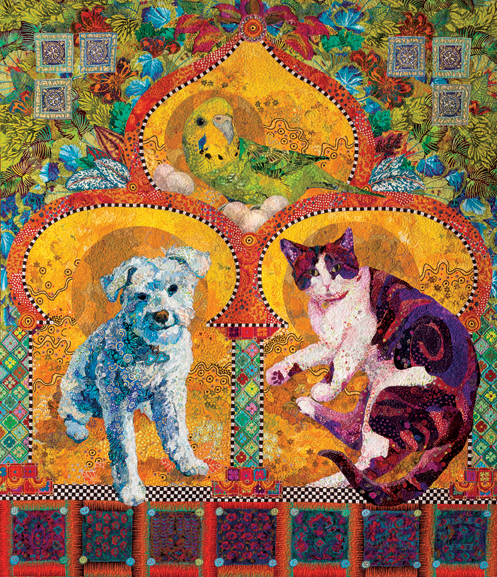
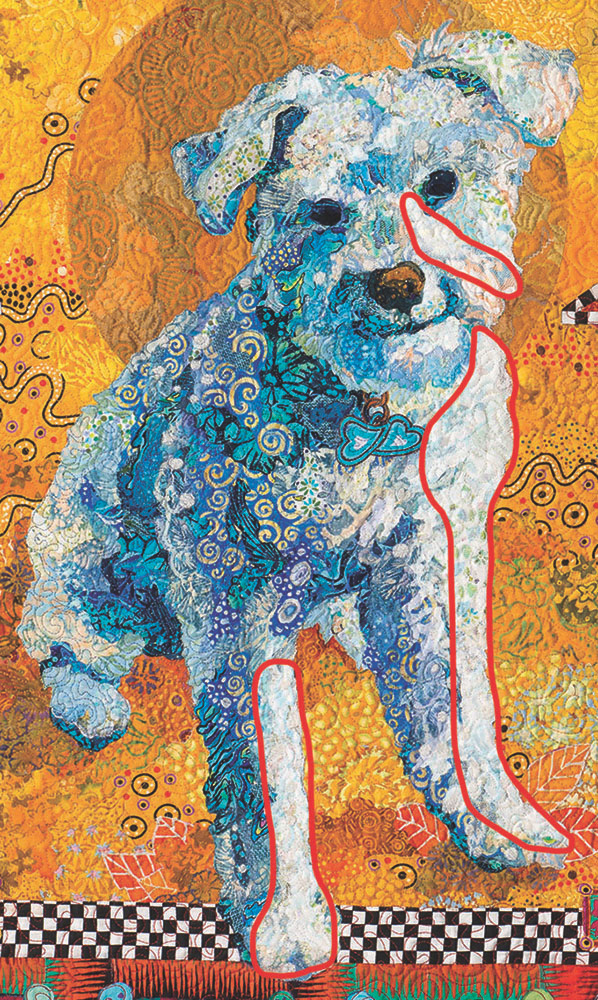


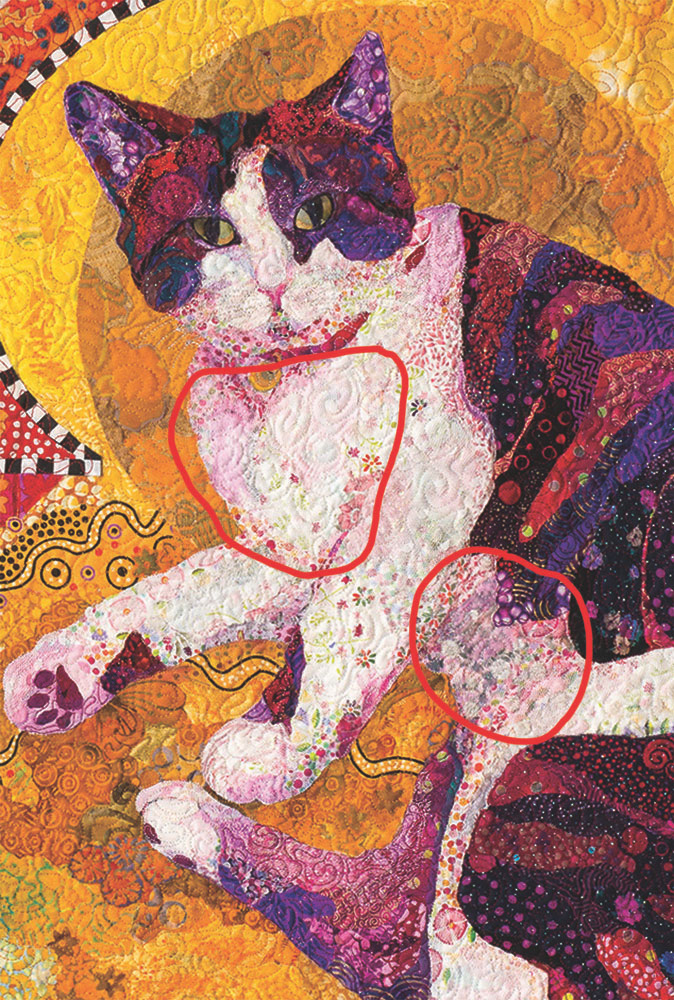


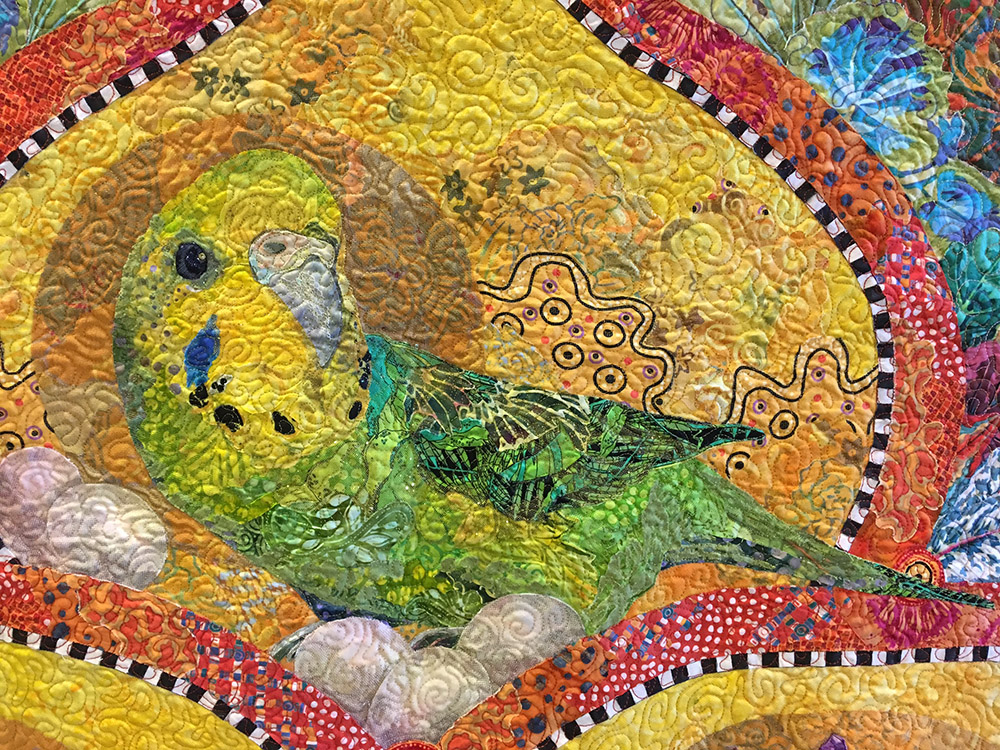
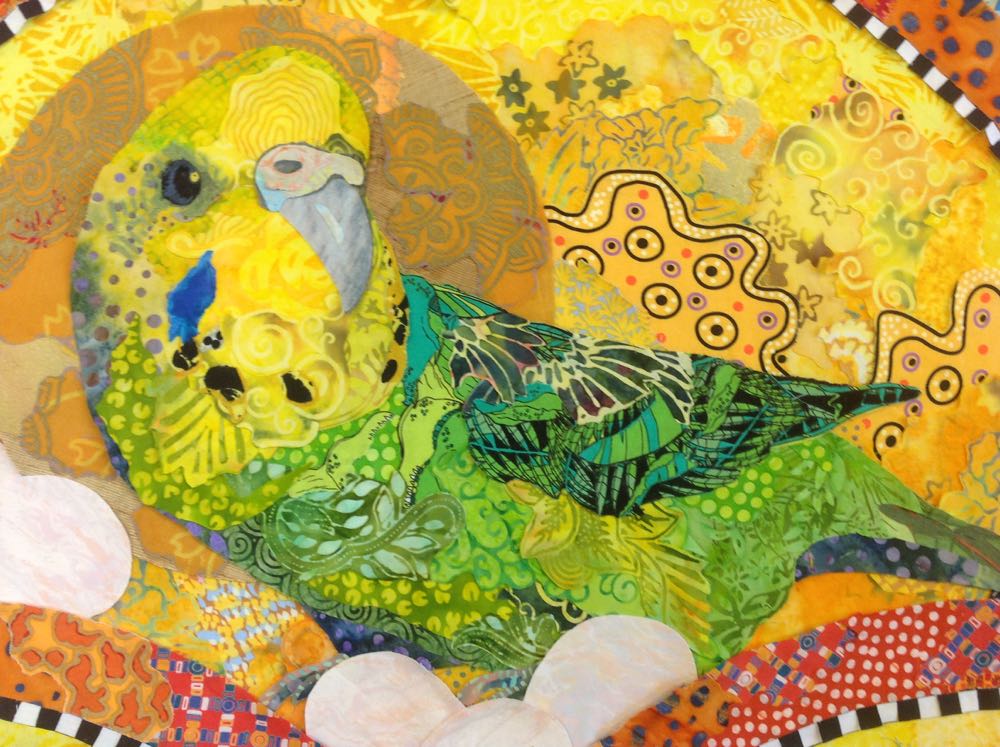
Wow! Thanks for this post. The pictures and text provide a fantastic description and illustration of the huge difference, especially, in dimension and texture, inclusion of sheers makes.